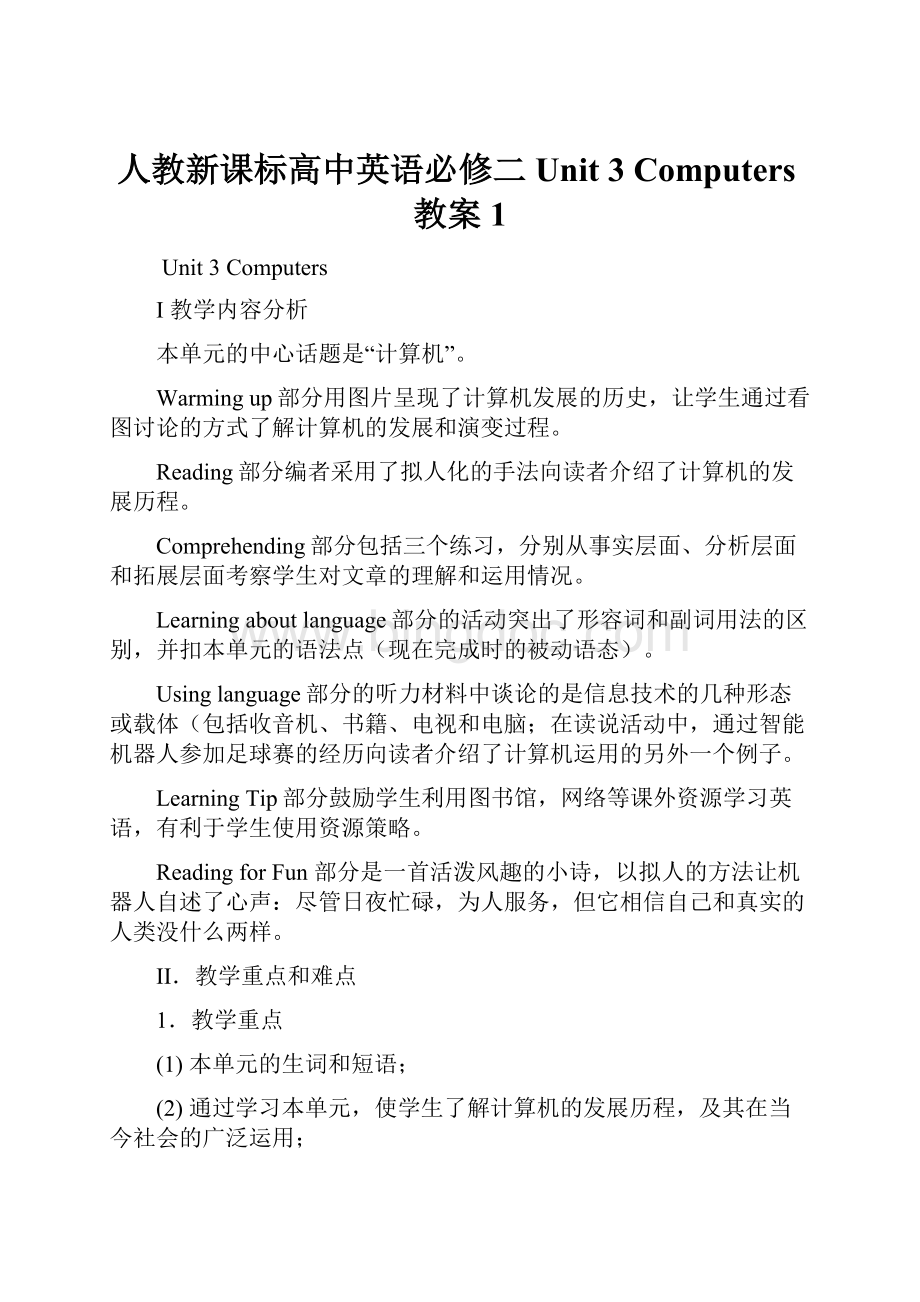人教新课标高中英语必修二Unit 3 Computers教案1.docx
《人教新课标高中英语必修二Unit 3 Computers教案1.docx》由会员分享,可在线阅读,更多相关《人教新课标高中英语必修二Unit 3 Computers教案1.docx(15页珍藏版)》请在冰点文库上搜索。

人教新课标高中英语必修二Unit3Computers教案1
Unit3Computers
I教学内容分析
本单元的中心话题是“计算机”。
Warmingup部分用图片呈现了计算机发展的历史,让学生通过看图讨论的方式了解计算机的发展和演变过程。
Reading部分编者采用了拟人化的手法向读者介绍了计算机的发展历程。
Comprehending部分包括三个练习,分别从事实层面、分析层面和拓展层面考察学生对文章的理解和运用情况。
Learningaboutlanguage部分的活动突出了形容词和副词用法的区别,并扣本单元的语法点(现在完成时的被动语态)。
Usinglanguage部分的听力材料中谈论的是信息技术的几种形态或载体(包括收音机、书籍、电视和电脑;在读说活动中,通过智能机器人参加足球赛的经历向读者介绍了计算机运用的另外一个例子。
LearningTip部分鼓励学生利用图书馆,网络等课外资源学习英语,有利于学生使用资源策略。
ReadingforFun部分是一首活泼风趣的小诗,以拟人的方法让机器人自述了心声:
尽管日夜忙碌,为人服务,但它相信自己和真实的人类没什么两样。
II.教学重点和难点
1.教学重点
(1)本单元的生词和短语;
(2)通过学习本单元,使学生了解计算机的发展历程,及其在当今社会的广泛运用;
(3)鼓励学生用英语表达自己的观点,进行简单的推理和做出决定。
2.教学难点
(1)教会学生通过时间的先后顺序来表达一件事;
(2)使学生了和掌握现在完成时的被动语态的用法;
(3)指导学生按类别归纳整理词汇,让学生学会有效地记忆词汇的方法;
(4)引导学生发现本单元重点语言结构,让学生自己发现并感悟相关的语言规律,在学习过程中培养语感。
III.教学计划
本单元分六课时:
第一课时:
WarmingUp,Pre-reading,Reading
第二课时:
Languagepoints
第三课时:
Learningaboutlanguage
第四课时:
Listening
第五课时:
Speaking,Reading,Writing
IV.教学步骤:
Period1WarmingUp,Pre-reading,Reading
TeachingGoals:
1.Toknowsomethingaboutcomputers.
2.Tolearnandtalkaboutcomputers.
TeachingProcedures:
Step1.Leading-in
Purpose:
ToactivatetheSsandarousethemtotalkabouttheimportanceofcomputersinmodernsociety.
AskSswhethertheyhaveacomputerornotandwhattheyuseitfor.Letthemtalkasmuchaspossible.
Step2.WarmingUp
Purpose:
TogetSstothinkaboutthedifferentwayscomputerscanbemade.
Pairwork
GetSstolookatthefollowingpictures,andthenaskthemtoanswerthequestions.
AhugecomputerAPC
AnotebookcomputerAcalculator
Anabacus
1.Whatarethey?
2.Whatdotheyhaveincommon?
3.Whatisacomputer?
SuggestedAnswers:
1.ahugecomputer,apersonalcomputer,anotebookcomputer,acalculator,anabacus
2.
(1)tobeusedtocalculate;
(2)operatebyhumanbeings;
(3)theyareallartificial;
(4)showfiguresinacertainway.
3.Acomputerisamachinewhichstoresknowledgeinitsmemoryanddoescalculationsonthatknowledge.Thisknowledgeisstoredinsymbols;itiscalleddata.Acomputerusuallyhasamonitortoshowresults.However,somecomputerscanspeak;thesecomputerscanbeusedforvoicemail.
Acomputerisnowalmostalwaysanelectronicdevice.Itusuallycontainsmaterialswhicharetoxic;thesematerialswillbecometoxicwastewhendisposedof.Whenanewcomputerispurchasedinsomeplaces,lawsrequirethatthecostofitswastemanagementmustalsobepaidfor.Thisiscalledproductstewardship.
Step3.Pre-reading
Purpose:
ToactivateSs’interestaboutcomputers.
Groupwork
AskSsthefollowingquestionsandencouragethemtosaymore.
1.Howhavecomputerschangedourlives?
2.Whatdoyouknowaboutcomputers?
SuggestedAnswers:
1.They’reamuchmoreusefulandhumanetoolthanthephone,andwithcorporateAmericabehindthemthenetworkswillbeeverywhere---changingourlivesmorethananytechnologysincetheautomobile.
2.Amulti-functionelectronicdevicethatcanexecuteinstructionstoperformatask.
Adevicethatacceptsinformation,processesit,andsuppliesanoutput.Acomputerusuallycontainsmemory,acontrolunit,arithmeticandlogicalunits,andameansforinputandoutput.
Aprogrammablehardwarecomponentthatiscontrolledbyinternallystoredprogramsandthatcanperformsubstantialcomputations(includingarithmeticandlogicoperations)withouthumanintervention.Acomputertypicallyconsistsofoneormoreprocessingunits,memoryunits,andassociatedperipheralinputandoutputdevices.
Step4.Reading
1.Skimming
Purpose:
1.Togetabriefunderstandingofthetext.
2.Totrainthestudents’listeningability.
First,letSsskimthetextandthenlistentotherecordingofthetext.Payattentiontothepausesandpronunciation.
2.Scanning
Purpose:
TogetSstohavesomedetailsinthetext.
Nowwearetoreadthetextagainandunderlinealltheexpressionsinthetext.Writethemdowninyournotebook.
3.FurtherReading
Purpose:
TogetSstogetmoredetailsaboutthetext.
Readthetextagainandfindtheinformationtocompletethetable,whichdescribesthedevelopmentofcomputer.
1642:
___________________________________________________
1822:
TheAnalyticalMachinewasmadebyCharlesBabbage.
____:
___________________________________________________
1940s:
___________________________________________________
_____:
Thefirstfamilyofcomputerswasconnectedtoeachother.
1970s:
___________________________________________________
Now:
___________________________________________________
Step5.Retell
Purpose:
Tohaveadeepunderstandingofthetext.
AskSstousethechartabovetoretellthedevelopmentofthecomputer.
Onepossibleversion:
I,acomputer,wasacalculatingmachinein1642inFrance.ThenIwasbuiltasanAnalyticalMachinein1822,whichwasatechnologicalrevolution.Ibecamea“universalmachine”in1936tosolveanymathematicalproblem.IwasnotverybigatfirstthenIbecamehuge,thesizeofalargeroombeforeIwasmadesmallerandsmaller.
Gettingnewtransistors,laterverysmallchipsIchangedmyshape.Iwasconnectedwithothercomputersandturnedouttopartofanetworkintheearly1960s.In1970sIwasbroughtintopeople’shomes,andcametheInternet.
Step6.Homework
1.Writeashortpassageaboutthedevelopmentofcomputers.
2.FinishEx1(P19),Ex2(P20).
Period2Languagepoints
Step1Wordstudy
Groupwork
DivideSsintofourgroupsandaskthemtodiscussthefollowingwords.
1.common
(1)mostwidelyknown;ordinary:
EgHeisacommonsailor.
(2)havenothing/little/something/alotincommon
EgAtfirst,Ithinkweonlyhadonethingincommon,butsuddenlyIfeltwehadalotincommon.
EgThetwobrothershadeverythingincommonintheirmanners,butthetwosistershavelittleincommon.
EgTheyhavenothingincommonwithoneanother.
2.analytical分析的
EgThescientistanalyzedthemilkandfounditcontainedtoomuchwater.
3.technology科技;技术
EgWiththedevelopmentoftechnology,wewillcureAIDSsoonerorlater.
4.calculate(v.)
1)tousenumberstofindoutatotalamount,distance,etc.计算;核算
Wehaven’treallycalculatedthecostofthevacationyet.
2)toguesssthbyusingalltheinformationavailable推测,估计
Itisimpossibletocalculatewhatinfluencehehadonherlife.
5.Astimewentby,Iwasmadesmaller.随着时间的推移,我被弄得越来越小。
goby:
topass逝去,过去
Thingswillgeteasierastimegoesby.随着时间的推移,情况会有所改善。
6.totally:
completely完全地;全部地;整个地
Theycomefromtotallydifferentcultures.他们来自完全不同的文化。
7.sharewith:
tohaveorusesthatthesametimeassbelse共用,合用
Marysharesahousewiththreeotherstudents.玛丽和另外三个学生合住一间房子。
Sharein分享,分担
8.explore(v.)
1)totraveltooraroundanareaoracountryinordertolearnaboutit勘察;探索;考察
Thecityisbestexploredonfoot.最好是徒步考察这个城市。
2)examinesthcompletelyorcarefullyinordertofindoutmoreaboutit.探究,调查研究
TheseideaswillbeexploredinmoredetailinChapter7.这些想法将在第七章里作更详细地探讨。
9.inaway:
toacertainextent在某种程度上
Inawayyouareright,butthisnewtextbookistooboring.从某种程度上说你是对的,但是这本新教材是很枯躁的。
Intheway阻碍,妨碍
Step2.Homework
Usethewordsabovetomakesentencesandcheckthemwithyourpartner.
Period3LearningaboutLanguage
Step1.LearningaboutLanguage
1.Filltheblanksandchecktheanswersaltogether.
(1)Snowis_______(常见的)incoldcountries.
(2).Canyou_______(估计)thecostofthisjourney?
(3).The_________(分析)ofthesamplesonthemurderspotshowedsomevaluableclues
tothepolice.
(4)Ishallgoandseehim________(无论如何)
(5)He'ssomekindof________(数学)genius.
(6).Heistoos________toworkoutsuchadifficultproblem.
(7).Heaskedhisfather'so________abouthisplans.
(8).Howareyougoingtod________withtheletter?
(9).I________(完全)agreetoyourplan.
(10).Thisisat________beautifulpicture.
2.Changethefollowingsentenceswiththemeaningnotchanged.
(1)Ilikealotofwhatshelikes.→
Wehavealot____________.
(2)HarryhelpedmewithmyEnglish,soIlearntalot.→
ImadegreatprogressinEnglish_______Harry's______.
(3)Timepassedquickly.Petergrewintoatallyoungman.→
Withthetime______________,Peterbecameatallyoungman.
(4)Yousaiditwasveryspecial.Idon'tthinkso.→
I_______withwhatyousaid.
(5)Inmyopinion,Mickeyisthekindofpersonweneed.→
_________,Mickeyistheverymanweneed.
3.Grammar
Purpose:
TogetSstohaveknowledgeofthisgrammarpoint:
presentperfectpassivevoice.
(1)Presentation
①Revisethegrammar:
thepresentpassivevoice.
am/is/are+done
②Revisethegrammar:
thepresentperfectvoice.
Have/has+done
③Explainthegrammar:
thepresentperfectpassivevoice.
——>Have/hasbeen+done
(2)Practice
Purpose:
TogetSstohaveknowledgeofthegrammarthroughexercise.
①Filltheblankswiththecorrecttense.
A.–Thewindowisdirty.
-It____________________(notclean)forweeks.
B.---GeorgeandLucygotmarriedlastweek.Didtheyhaveabigwedding?
---No,I__________________(notinvite).
Didtheyhaveabigwedding?
.C.---Haveyoumovedtoyournewapartment?
---Notyet,it_______________(paint)atthemoment.
D.toomuch.Thestudentshavebeenmade__________(notplay)computergames
E.Sincethen,alldifferentkindsofinformation____________________(处理)bycomputers.
F.Hedoesn’tmindthestory_____________(编造)inthisway.
G.Doyouknowhowmanywebsitesthereare________________(连接)?
SuggestedAnswers:
A.hasn’tbeencleanedB.hadn’tbeeninvitedC.isbeingpaintedD.nottoplayE.hasbeendealtwithF.beingmadeupG.tobeconnected
②TranslatingfollowingsentencesintoChineseandpayattentiontothepresentpas